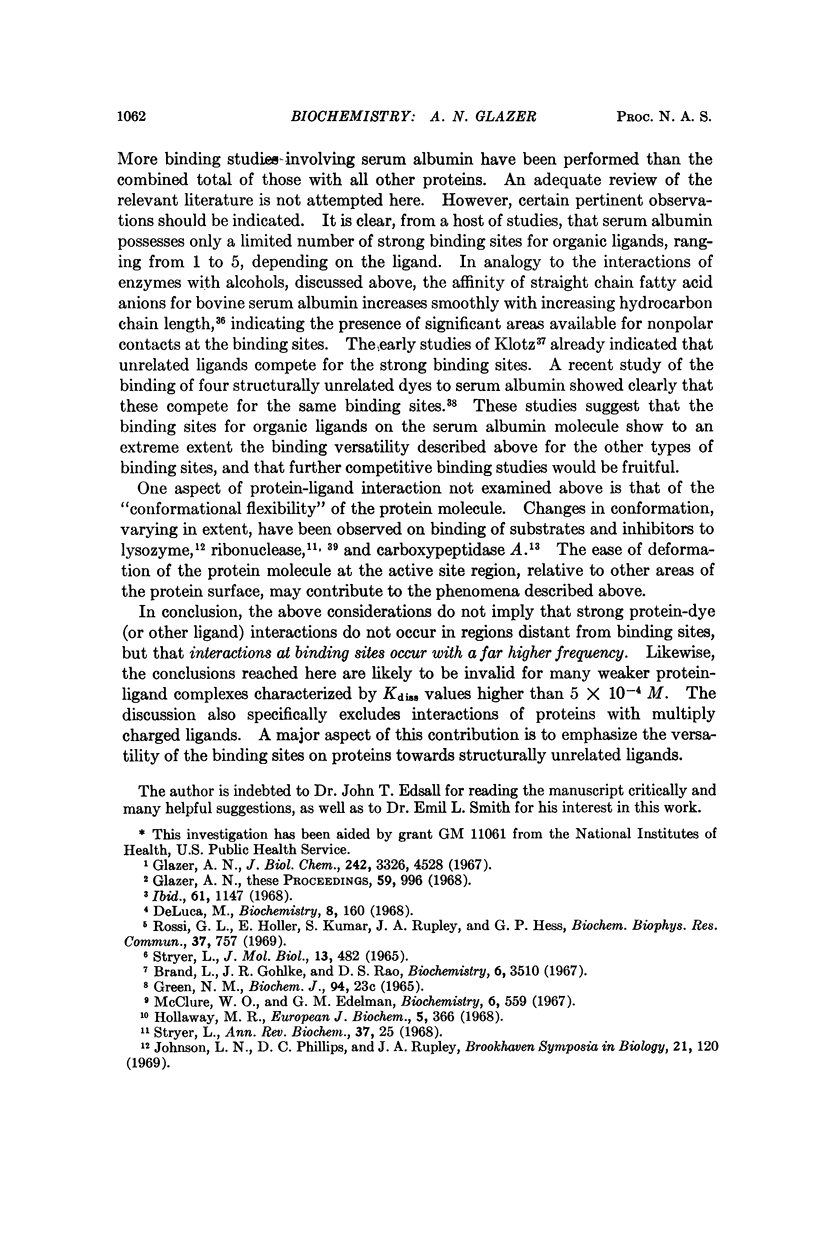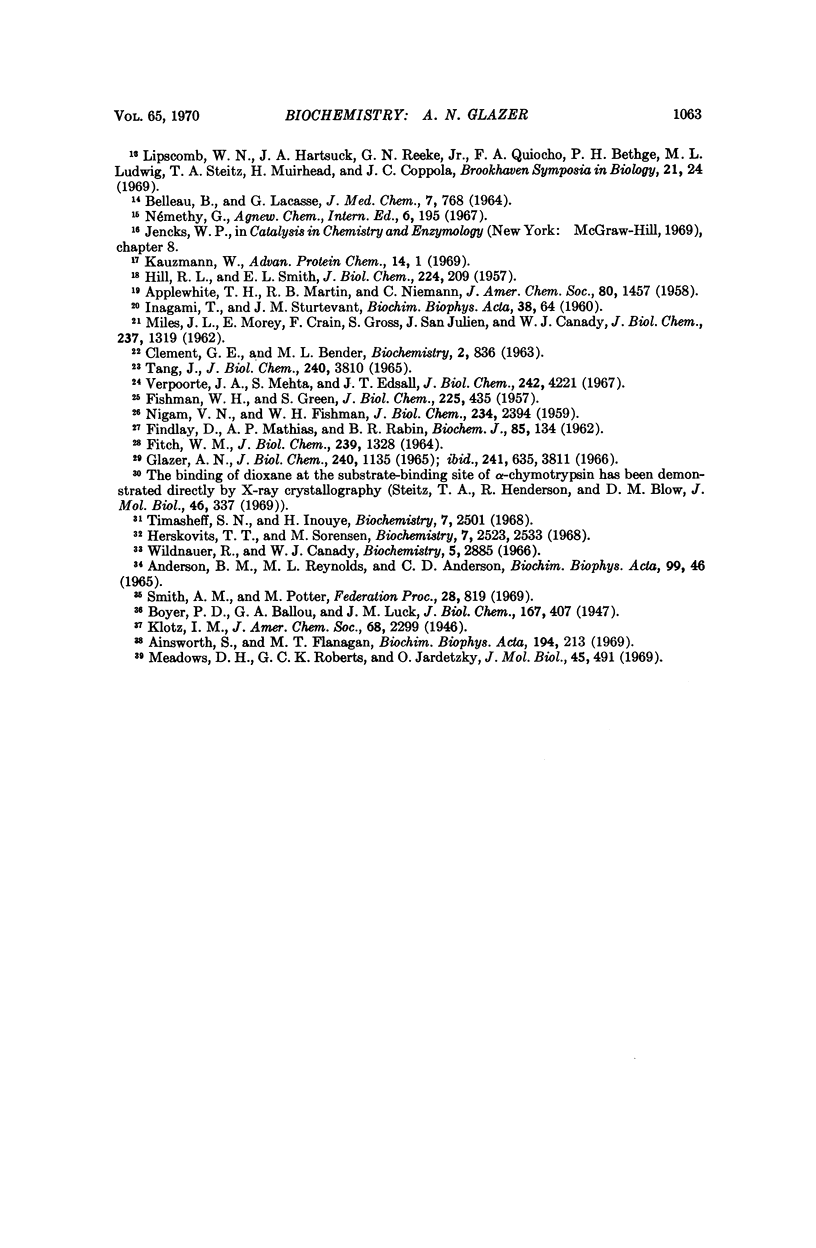Abstract
Strong binding of dyes to simple globular proteins takes place predominantly in areas overlapping the binding sites for substrates, coenzymes and prosthetic groups, in preference to other regions of the protein surface. The structure of the dyes bears no obvious relationship to that of the normal ligands. It is proposed that this phenomenon is a reflection of the special stereochemical features of such sites, their hydrophobicity relative to other portions of the protein surface, and, possibly, greater flexibility in these regions of the protein molecule. The binding properties of antibodies and bovine serum albumin are discussed in relation to this apparent versatility of protein binding sites towards structurally unrelated organic ligands.
Full text
PDF






Selected References
These references are in PubMed. This may not be the complete list of references from this article.
- ANDERSON B. M., REYNOLDS M. L., ANDERSON C. D. HYDROPHOBIC INTERACTIONS OF INHIBITORS WITH YEAST ALCOHOL DEHYDROGENASE. Biochim Biophys Acta. 1965 Apr 26;99:46–55. doi: 10.1016/s0926-6593(65)80006-6. [DOI] [PubMed] [Google Scholar]
- Ainsworth S., Flanagan M. T. The effects that the environment exerts on the spectroscopic properties of certain dyes that are bound by bovine serum albumin. Biochim Biophys Acta. 1969 Nov 11;194(1):213–221. doi: 10.1016/0005-2795(69)90196-2. [DOI] [PubMed] [Google Scholar]
- BELLEAU B., LACASSE G. ASPECTS OF THE CHEMICAL MECHANISM OF COMPLEX FORMATION BETWEEN ACETYLCHOLINESTERASE AND ACETYLCHOLINE-RELATED COMPOUNDS. J Med Chem. 1964 Nov;7:768–775. doi: 10.1021/jm00336a021. [DOI] [PubMed] [Google Scholar]
- Brand L., Gohlke J. R., Rao D. S. Evidence for binding of rose bengal and anilinonaphthalenesulfonates at the active site regions of liver alcohol dehydrogenase. Biochemistry. 1967 Nov;6(11):3510–3518. doi: 10.1021/bi00863a024. [DOI] [PubMed] [Google Scholar]
- CLEMENT G. E., BENDER M. L. THE EFFECT OF APROTIC DIPOLAR ORGANIC SOLVENTS ON THE KINETICS OF ALPHA-CHYMOTRYPSIN-CATALYZED HYDROLYSES. Biochemistry. 1963 Jul-Aug;2:836–843. doi: 10.1021/bi00904a036. [DOI] [PubMed] [Google Scholar]
- DeLuca M. Hydrophobic nature of the active site of firefly luciferase. Biochemistry. 1969 Jan;8(1):160–166. doi: 10.1021/bi00829a023. [DOI] [PubMed] [Google Scholar]
- FISHMAN W. H., GREEN S. Enzymic catalysis of glucuronyl transfer. J Biol Chem. 1957 Mar;225(1):435–452. [PubMed] [Google Scholar]
- FITCH W. M. STUDIES ON A CHOLINESTERASE OF PSEUDOMONAS FLUORESCENS. 3. ACETYLTRANSFERASE ACTIVITY. J Biol Chem. 1964 May;239:1328–1334. [PubMed] [Google Scholar]
- Findlay D., Mathias A. P., Rabin B. R. The active site and mechanism of action of bovine pancreatic ribonuclease. 4. The activity in inert organic solvents and alcohols. Biochem J. 1962 Oct;85(1):134–139. doi: 10.1042/bj0850134. [DOI] [PMC free article] [PubMed] [Google Scholar]
- GLAZER A. N. TRANSESTERIFICATION REACTIONS CATALYZED BY TRYPSIN. J Biol Chem. 1965 Mar;240:1135–1137. [PubMed] [Google Scholar]
- Glazer A. N. The specific binding of Biebrich Scarlet to the active site of alpha-chymotrypsin. J Biol Chem. 1967 Oct 10;242(19):4528–4533. [PubMed] [Google Scholar]
- Glazer A. N. The time-dependent specific interation of 4-(4'-aminophenylazo)phenylarsonic acid with subtilsins. Proc Natl Acad Sci U S A. 1968 Mar;59(3):996–1002. doi: 10.1073/pnas.59.3.996. [DOI] [PMC free article] [PubMed] [Google Scholar]
- Glazer A. N. Transesterification reactions catalyzed by papain. J Biol Chem. 1966 Aug 25;241(16):3811–3817. [PubMed] [Google Scholar]
- HILL R. L., SMITH E. L. Leucine aminopeptidase. VI. Inhibition by alcohols and other compounds. J Biol Chem. 1957 Jan;224(1):209–223. [PubMed] [Google Scholar]
- Herskovits T. T., Sorensen M. Studies of the location of tyrosyl and tryptophyl residues in proteins. I. Solvent perturbation data of model compounds. Biochemistry. 1968 Jul;7(7):2523–2532. doi: 10.1021/bi00847a012. [DOI] [PubMed] [Google Scholar]
- Hollaway M. R. The proflavin-induced increase in the catalytic activity of ficin. Eur J Biochem. 1968 Aug;5(3):366–375. doi: 10.1111/j.1432-1033.1968.tb00379.x. [DOI] [PubMed] [Google Scholar]
- INAGAMI T., STURTEVANT J. M. The trypsin-catalyzed hydrolysis of benzoyl-L-arginine ethyl ester. I. The kinetics in dioxane-water mixtures. Biochim Biophys Acta. 1960 Feb 12;38:64–79. doi: 10.1016/0006-3002(60)91196-3. [DOI] [PubMed] [Google Scholar]
- Johnson L. N., Phillips D. C., Rupley J. A. The activity of lysozyme: an interim review of crystallographic and chemical evidence. Brookhaven Symp Biol. 1968 Jun;21(1):120–138. [PubMed] [Google Scholar]
- KAUZMANN W. Some factors in the interpretation of protein denaturation. Adv Protein Chem. 1959;14:1–63. doi: 10.1016/s0065-3233(08)60608-7. [DOI] [PubMed] [Google Scholar]
- Lipscomb W. N., Hartsuck J. A., Reeke G. N., Jr, Quiocho F. A., Bethge P. H., Ludwig M. L., Steitz T. A., Muirhead H., Coppola J. C. The structure of carboxypeptidase A. VII. The 2.0-angstrom resolution studies of the enzyme and of its complex with glycyltyrosine, and mechanistic deductions. Brookhaven Symp Biol. 1968 Jun;21(1):24–90. [PubMed] [Google Scholar]
- MILES J. L., MOREY E., CRAIN F., GROSS S., SAN JULIAN J. S., CANADY W. J. Inhibition of alpha-chymotrypsin by diethyl ether and certain alcohols: a new type of competitive inhibition. J Biol Chem. 1962 Apr;237:1319–1322. [PubMed] [Google Scholar]
- McClure W. O., Edelman G. M. Fluorescent probes for conformational states of proteins. II. The binding of 2-p-toluidinylnaphthalene-6-sulfonate to alpha-chymotrypsin. Biochemistry. 1967 Feb;6(2):559–566. doi: 10.1021/bi00854a025. [DOI] [PubMed] [Google Scholar]
- Meadows D. H., Roberts G. C., Jardetzky O. Nuclear magnetic resonance studies of the structure and binding sites of enzymes. 8. Inhibitor binding to ribonuclease. J Mol Biol. 1969 Nov 14;45(3):491–511. doi: 10.1016/0022-2836(69)90308-8. [DOI] [PubMed] [Google Scholar]
- NIGAM V. N., FISHMAN W. H. Catalysis of phosphoryl transfer by prostatic acid phosphatase. J Biol Chem. 1959 Sep;234:2394–2398. [PubMed] [Google Scholar]
- Rossi G. L., Holler E., Kumar S., Rupley J. A., Hess G. P. Labelling of the catalytic site of lysozyme. Biochem Biophys Res Commun. 1969 Nov 20;37(5):757–766. doi: 10.1016/0006-291x(69)90956-5. [DOI] [PubMed] [Google Scholar]
- Steitz T. A., Henderson R., Blow D. M. Structure of crystalline alpha-chymotrypsin. 3. Crystallographic studies of substrates and inhibitors bound to the active site of alpha-chymotrypsin. J Mol Biol. 1969 Dec 14;46(2):337–348. doi: 10.1016/0022-2836(69)90426-4. [DOI] [PubMed] [Google Scholar]
- Stryer L. Implications of X-ray crystallographic studies of protein structure. Annu Rev Biochem. 1968;37:25–50. doi: 10.1146/annurev.bi.37.070168.000325. [DOI] [PubMed] [Google Scholar]
- Stryer L. The interaction of a naphthalene dye with apomyoglobin and apohemoglobin. A fluorescent probe of non-polar binding sites. J Mol Biol. 1965 Sep;13(2):482–495. doi: 10.1016/s0022-2836(65)80111-5. [DOI] [PubMed] [Google Scholar]
- Tang J. Competitive inhibition of pepsin by aliphatic alcohols. J Biol Chem. 1965 Oct;240(10):3810–3815. [PubMed] [Google Scholar]
- Timasheff S. N., Inoue H. Preferential binding of solvent components to proteins in mixed water--organic solvent systems. Biochemistry. 1968 Jul;7(7):2501–2513. doi: 10.1021/bi00847a009. [DOI] [PubMed] [Google Scholar]
- Verpoorte J. A., Mehta S., Edsall J. T. Esterase activities of human carbonic anhydrases B and C. J Biol Chem. 1967 Sep 25;242(18):4221–4229. [PubMed] [Google Scholar]
- Wildnauer R., Canady W. J. A hydrocarbon-water model for the formation of the enzyme-inhibitor complex in the case of alpha-chymotrypsin. Biochemistry. 1966 Sep;5(9):2885–2892. doi: 10.1021/bi00873a016. [DOI] [PubMed] [Google Scholar]


